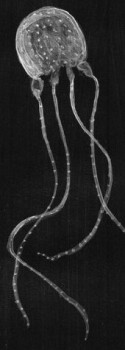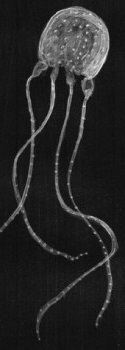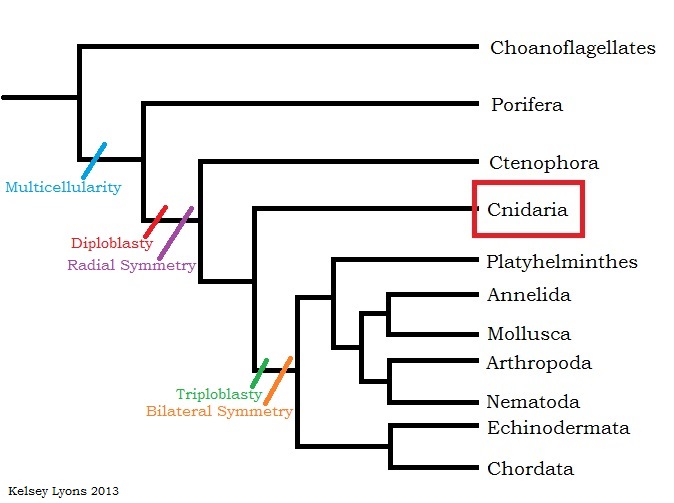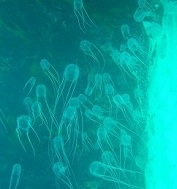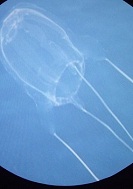Classification
If you'd like to learn about how this jellyfish got its name or how it is related to other organisms, keep scrolling down!
The Carukia barnesi's exact classification is always up for debate, as are many other organisms' classifications. Science is always changing and evolving, and with that, the characteristics which define a class, order, family, etc. are also always changing, or include some gray areas. This classification is the most prevalent one that I found while researching.
Domain: Eukarya
Kingdom: Animalia
Phylum: Cnidaria
Class: Cubozoa
Order: Cubomedusae
Family: Caybdeidae
Genus: Carukia
Species: Carukia barnesi
Domain
Eukarya: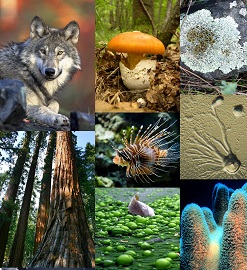 Wikimedia Commons: Eryn Blaire |
This domain contains animals, plants, fungi, and protists; pretty much everything besides bacteria and archaea (which are under the domain Prokarya). In order to be classified as eukaryotic, an organism must have membrane-bound organelles (such as the Golgi apparatus, mitochondria, chloroplasts, etc.) and a distinct nucleus (which houses genetic material, DNA). |
|
Kingdom Animalia: 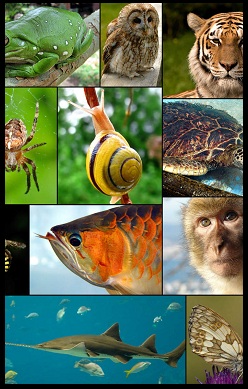 Wikimedia Commons: Justin |
Lions and tigers
and bears, oh my! Yes, those animals are included under
this category, but this kingdom also has many non-furry organisms that you
probably won’t find at the zoo:
sponges,
tapeworms,
cockroaches, raccoons,
komodo dragons, and yes, the Irukandji Jellyfish all fall into the Kingdom
Animalia! All organisms in this kingdom exhibit the following characteristics:
multicellularity, lack cell walls, made up of cells that are then organized into
tissues (with the exception of sponges), and a heterotrophic diet. Most species
in this kingdom also reproduce sexually, have an internal cavity for digesting
food, and are able to have some form of locomotion.
(Myers 2001) |
|
Phylum
Cnidaria: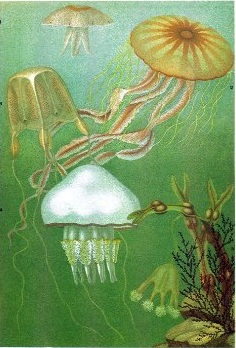 Brockhaus and Efron Encyclopedic Dictionary |
This Phylum includes many well-known marine species: corals,
anemones, hydras,
and of course, the jellyfish! All of these organisms exhibit
radial symmetry,
dipoblasticity, tentacles with
cnidocytes that house the
nematocysts (stinging
cells), and a digestive cavity with a single opening. Cnidarians can have a
polyp phase,
medusa phase,
or both, in their life cycles. Also, these organisms reproduce via asexual,
sexual, or sometimes both asexual and sexual reproduction. |
|
Class
Cubozoa:  Wikimedia Commons: Arthurfogo7 |
This is the class specifically for the very venomous cnidarians known as the
box jellyfish; this is “because in transverse section the
bells appear to be
square.” These organisms’ tentacles, which are visibly flattened at their bases,
can be found at the corners of the bell. Also, Cubozoans exhibit “a rim called a
velarium,” caused by the edge of the bell being turned inwards
(Myers and
Burch 2001) Also, this class displays exceptional hunting skills due to their
great swimming abilities and possession of
eyes. Some organisms can have as many
as 24 eyes, with two pairs being extremely sensitive to light and dark.
|
|
Order Cubomedusae:  Wikimedia Commons: Zaneta Nemcokova |
In this order, specific characteristics really begin to surface. For example,
all organisms in the Cubomedusae have only four tentacles, or at very rare
times, have no more than two to three tentacles in each of the four groupings.
Each of these tentacles has its own pedalium.
(Gegenbaur 1865)
Also, the Cubomedusae’s inner organs include the following: “four wide perradial sacs
extending outwards from the central stomach into the subumbrellar cavity,” "interradial
septa," "four pairs of leaf-shaped gonads," and a
velarium which partially
covers the bell cavity opening. (Kramp 1961)
|
|
Family Carybaeidae: 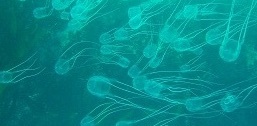 Wikimedia Commons: Peter Southwood |
This family has a wide range in bell size with “the smallest only 6-8mm,” which is right where our Carukia barnesi fits in! These organisms are also characterized by their transparent bells. (Rifkin 1996) |
|
Genus Carukia:  Wikimedia Commons: Unknown |
This genus differs from others because of the absence of the gastric phacellae
(Southcott 1967). A gastric phacellae is defined as “the rows of
filaments…bearing nematocysts on the inner surface of the gastric cavity of
some…jellyfishes” (Merriam-Webster 2013). |
|
Species Carukia barnesi:  Wikimedia Commons: GondwanaGirl |
You have made it to the species! This little jelly is so interesting that I cannot include everything about it in one description paragraph. So, what do you want to learn about? Its habitat? Structure? Nutrition? Reproduction? Interactions? Simply click on one of these links, one of the subjects on the left side of the screen, or keep scrolling down to learn more about our venomous little friend, the Irukandji jellyfish! |
So What Does the Name Mean?
The later part of the species name, barnesi, comes from the name of the daring Dr. Jack Barnes, who, in 1956, discovered this organism that causes true Irukandji syndrome (whereas other jellyfish can cause some similar symptoms, but not all the issues nor to the same intensity). If you click here, you can learn about the kooky way that Dr. Barnes tested to see if this species was the culprit of Irukandji syndrome.
In 1952, Hugo Flecker thoroughly explained the origin and reason for Carukia
barnesi’s common name:
“The name Irukandji has been chosen
in the absence of knowledge of the identity of the offending object and of any
distinctive character amongst the symptoms. It is the name of an aboriginal
tribe which formerly inhabited the coastal region between the Mowbray River to
the north and the Trinity Inlet around Cairns to the south. Most of the recorded
victims were stung in this region, and although the injury is not limited to
this area… no more appropriate geographical name can be found at present.”
(Nickson 2009)
Phylogenetic Trees
Modified from Campbell and Reece 2009
This tree displays some of the Phyla within the Kingdom Animalia. Unicellular Choanoflagellates (at the very top of the tree, depicting that this group is the least evolved or least derived) are said to be the ancestors of all the animals. After that, the Phyla progress down, based on derived traits. First evolved traits shown are multicellularity and asymmetry (not having any line of symmetry) with the Porifera (sponges). It can be seen that true tissue and some form of symmetry do not evolve until the Ctenophora (which includes the Comb Jellyfish). The Ctenophora and Cnidaria (which is where our Irukandji Jellyfish can be found!) are diploblastic (having two layers of tissues) and radially symmetrical (have a line of symmetry no matter where a cut is made). Then, after the Cnidaria, more traits evolve: triploblasticity (having three layers of tissues) and bilateral symmetry (only one line of symmetry). These new traits allowed for more complex organisms, such as tapeworms in Phylum Platyhelminthes, squid in Phylum Mollusca, and us humans in Phylum Chordata. So as you can see from this phylogeny, Cnidaria aren’t exactly the most evolved or complex organisms on this planet, but they are still very fascinating and important to our world!
In 2009, Bentlage, et. al published a research paper named the “Evolution of box jellyfish (Cnidaria: Cubozoa), a group of highly toxic invertebrates.” For a part of their experiment they created a phylogenetic tree in order to see the closest relationships within the Class Cubozoa. In order to generate this phylogeny, Bentlage et. al collected and preserved tentacle tissue, from which they later extracted DNA. This was then sequenced and genes were analyzed to sort the different species into their proper groupings. The tree above shows four of the twenty-six species Bentlage, et. al categorized; these are the closest relatives to C. barnesi: Malo kingi, Morbakka virulenta, and Gerongia rifkinae.
Next stop: Habitat
UW-L
Last Updated: April 26, 2013
